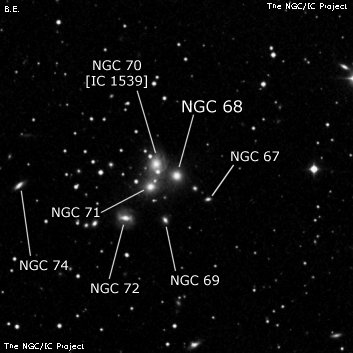
William Herschel discovered NGC 68 = H V-16 = h15 on 11 Sep 1784 (sweep 266) and recorded "eF, 5 or 6' dia, 3 or 4 stars in it; but they seem to have connection with it." This is the only galaxy Herschel discovered in the group, but he listed it in his fifth class of "large" nebulae, and Corwin comments it's likely he saw the merged light of NGC's 68, 70, and 71 (3 brightest in a small triangle in the core). JH made a similar observation. On 16 Sep 1828 he wrote "An extr F cluster with neb 5' diam. Several *s 15...18m. Seen distinctly, but there is also unresolved nebulosity. R.J. Mitchell, observing with the 72" on 7 Oct 1855, made a sketch of NGC 67, 68, 69, 70, 71, 72, 74 (1861 LdR publication). The NGC position matches UGC 170 = PGC 1187.
400/500mm - 17.5" (8/27/87): faint, small, slightly elongated WNW-ESE, weak concentration. This galaxy is the brightest in a compact group and first in an interconnected trio with NGC 70 1.0' NE and NGC 71 1.2' SE. An extremely difficult galaxy, NGC 67, is just 0.9' SW.
600/800mm - 24" (9/15/12): at 322x appeared fairly faint to moderately bright, fairly small, round, 25" diameter, high surface brightness though contains a brighter nucleus. One of the brighter members in a dense group of galaxies and forms a tight trio with NGC 70 1.0' NE and NGC 71 1.3' SE. In addition, CGCG 499-104 is just 57" SW. In total, 10 galaxies were logged in a 5' circle!
Notes by Steve Gottlieb